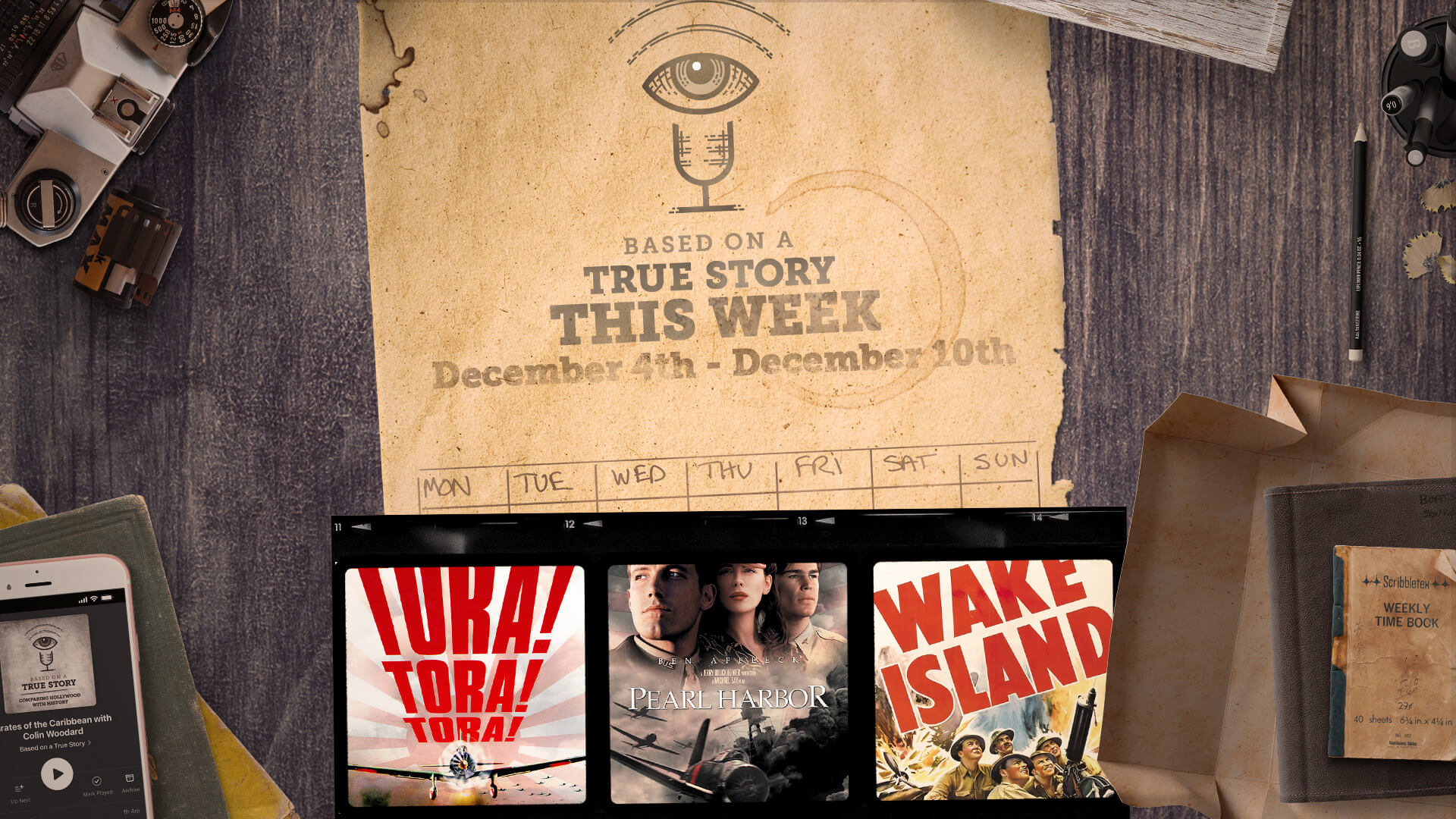In this episode, we’ll learn about historical events that happened this week in history as they were depicted in The Pacific, The Crucible, and The Battle of Britain.
Did you enjoy this episode? Help support the next one!
Disclaimer: Dan LeFebvre and/or Based on a True Story may earn commissions from qualifying purchases through our links on this page.
Transcript
Note: This transcript is automatically generated. There will be mistakes, so please don’t use them for quotes. It is provided for reference use to find things better in the audio.
August 15, 1945. Long Island, New York.
An elevator dings as the scene fades up from black to reveal we’re inside a hospital. A line of beds are filled with men. We can hear a woman speaking, saying nothing of huge importance to the storyline but then the camera cuts closer to where we can see that she’s reading from a book, saying things like:
“…Then bethought them of the blessed boon of sleep; but Achilles still wept for thinking of his dear comrade…”
The series doesn’t mention this, but that’s Homer’s Iliad.
The camera pans over to a couple of the guys in the hospital beds. The man further away from the camera is heavily bandaged. His fingers, wrist, arm, head, eye, all have bandages…there’s also a metal contraption of some sort around his chest, neck, and although the camera angle makes it hard to see everything it looks like there might be something attached to his legs, too.
In the foreground of the camera’s shot is a man without any visible bandages. Neither of the men are paying attention to the woman reading to them, but the man in the foreground is reading the newspaper. It looks like he’s reading the comic strips.
Oh, there we go, she just noticed they’re not paying attention to her. She puts down the book and says, “Hey, you’re not listening to me.”
Putting a cigarette to his mouth as he puts down the paper, the man who was reading the comics says they were listening. He puts a cigarette in the other guy’s mouth—I’m guessing he can’t move his arms enough to smoke on his own. Each of the men take a drag on their cigarettes, the smoke swirling as they blow out.
He recites the last few things she read, proving he was paying attention. Then, he looks back at the newspaper and suggests he read a comic to the other guy all bandaged up.
In the background, we can hear a door open.
The camera cuts to a man walking into the room. He looks around. Then, addressing no one in particular, he blurts out the news. The Japanese have surrendered.
Everyone looks at him, including the two men who were preoccupied by the comics and being read to.
The man standing there smiles, laughs a bit. Then he continues, “The war’s over!” He says.
Murmurs start among everyone in the room. A woman’s voice in the back confirms the news as we can see a nurse excitedly saying it’s definite. It’s on the radio! The war is over!
This is how the HBO miniseries called The Pacific shows an event that happened this week in history when Japan surrendered on August 15th, 1945, bringing World War II to an end. Or, as it’s sometimes called, V-J Day. Victory over Japan Day.
It’s also known as V-P Day or Victory in the Pacific Day, since it’s the Pacific Theater of the war as opposed to the European Theater. When that came to an end with the fall of Nazi Germany, May 8th, 1945, became known as V-E Day, Victory in Europe. We talked about back in episode #246 for the BOATS This Week covering May 8th, 1945. So, I thought it’d be fitting to use how another HBO miniseries covers V-J Day.
Although, it’s worth pointing out that is not technically when Japan surrendered.
V-J Day or V-P Day, whichever you prefer, is commonly known as August 15th, 1945. But that wasn’t the official surrender. That commemorates the announcement of surrender. Or, due to time zone differences, August 14th in the United States is when it was broadcast. So, the series is correct to suggest that’d be when people found out about it. However, the formal surrender happened a couple weeks later, on September 2nd. That’s also why sometimes people refer to September 2nd as V-J Day.
Naturally, some historical sticklers who point out its September 2nd, and technically they’re not wrong, but in The Pacific they mention August 15th, which is why we’re including it this week. Of course, just like Band of Brothers doesn’t show the actual surrender itself, neither does The Pacific. It’s showing what happened on the day for the characters the series is about.
So, to give a little more historical context that we don’t see in the series, on July 26th, 1945, the Allies sent the Japanese government what’s known as the Potsdam Declaration. That’s named after Potsdam, Germany, the name of the city where a conference between the three leading Allies took place to draw up a plan for peace.
Maybe you’ve seen the photograph of Winston Churchill, Harry S. Truman, and Joseph Stalin sitting together…that happened at the Potsdam Conference. If you haven’t seen it, here’s a photo of it:

The Declaration, though, essentially defined the terms of surrender for the Japanese. It was quite literally an unconditional surrender, as the end of the document said:
“We call upon the government of Japan to proclaim now the unconditional surrender of all Japanese armed forces, and to provide proper and adequate assurances of their good faith in such action. The alternative for Japan is prompt and utter destruction.”
The Japanese government’s reply was mokusatsu. Or, basically, to ignore it. The exact meaning of that word has been debated ever since. The United States government took it as being ignored, though.
The decision to drop the atomic bombs was made and, on August 6th, Little Boy was dropped on Hiroshima. On August 8th, the Soviet Union officially declared war on Japan and launched an offensive into Japanese-occupied Manchuria with over a million Soviet soldiers. Then, on August 9th, Fat Man was dropped on Nagasaki.
So, to summarize, what happened on August 15th, was the Japanese government announced they would be accepting the Potsdam Declaration.
With the announcement, bombers on Tinian Island getting ready for a mission over Japan were called off. Or, at least, put on hold to make sure the Japanese announcement was something they were going to follow through with.
They did.
The formal document of surrender was signed on the deck of USS Missouri in Tokyo Bay on September 2nd, 1945.
If you want to watch this week in history as it’s shown in HBO’s The Pacific, the text on screen saying it’s August 15th, 1945 is how the 10th and final episode of the series begins.
August 19, 1692. Salem, Massachusetts.
“Now, Mr. Proctor. Did you bind yourself to the devil’s service?”
Daniel Day-Lewis’s character, John Proctor, is standing there across from Paul Scofield’s character, Judge Thomas Danforth.
Judge Danforth tells John that he must write it down so they can put it on the church door as a good example to bring them to God.
There are two women in a cart behind Judge Danforth, but he’s not looking at them. He looks at John and Elizabeth Proctor standing in front of him. Danforth is only talking to John, though.
He asks the question again.
“Did you bind yourself to the devil’s service?”
John pauses for a moment. Then he offers his reply, “I did.”
Judge Danforth turns to the women in the cart now, saying there’s no point in keeping the conspiracy. Confess with him!
Elizabeth Lawrence’s version of Rebecca Nurse is tied to the cart behind Judge Danforth. She bursts out, “It is a lie!”
Judge Danforth asks if John Proctor saw anyone else with the devil—Rebecca Nurse, Mary Easty, Giles Corey, Martha Corey?
John says no, he did not.
Anyone?
John: No, I did not.
Others around Judge Danforth tell him to let John sign and be done with it!
A moment’s pause. Then, a quill is handed to John Proctor. He looks at a piece of paper…and signs his name.
This is how the 1996 movie The Crucible just starts a sequence that continues on—but it’s showing something that happened this week in history when five people were hung in what we now know as the Salem Witch Trials.
Although the movie’s portrayal of events are highly dramatized, it is correct to show that John Proctor—Daniel Day-Lewis’ character—was someone who was killed by hanging this week in history on August 19th, 1692.
He was one of 19 total people who were executed by hanging throughout the duration of the witch trials that took place between February of 1692 and May of 1693.
Almost all of the accusations were circumstantial at best, and nothing that would hold up in a court of law today. There are a lot of people who think the true motivation started off small and innocent before spreading into landowners realizing they could take advantage of it to legally take the land and possessions of their neighbors.
Is that what really happened? Well, I guess that’s something that keeps the Salem Witch Trials at the forefront of our curiosities because there are so many debates about the true causes and motivations behind what happened.
Regardless of any of the circumstantial evidence, the baseless accusations or the religious fever that gripped the region—at the end of the day, there were over 200 people accused of witchcraft. 30 were found guilty. 19 people were executed by hanging, five people died in jail as a result and one man, Giles Corey, was tortured to death by being pressed—the slow process of adding stones on top of him until he was killed.
This all happened in the United States thanks to religious people who were so set in their ways that they were okay with killing their own neighbors simply because someone accused them of witchcraft.
When, in reality, those accusations have been analyzed over the centuries and there have been numerous explanations—and no matter what outcome you believe, at the end of the day, everyone can agree that there was no valid reason for the hysteria to kill their neighbors.
If you want to see the event that happened this week in history, though, check out the 1996 movie called The Crucible. Our segment today started at about an hour and 50 minutes into the movie. And if you want to learn even more about the true story, we did a deep dive into the history that you can find at basedonatruestorypodcast.com/143.
August 18, 1940. Great Britain.
A squadron of airplanes are flying in formation over white, puffy clouds set against the blue sky. One of the pilots cranes his neck slightly to look below him. The camera cuts to down below on the ground, where we can see a soldier casually going about his day, about to hop onto a bicycle, it looks like.
He looks up and sees the black dots in the sky. The airplanes are coming closer.
“Stukas!” he says, as he runs for cover.
The airplanes start diving down, straight down. One by one they drop their bombs before pulling out of the dive. In the foreground, we can see a large metal array of wires and structures that are being destroyed as bombs hit near and, sometimes, directly on the structure.
Nearby buildings also burst into flame as bombs drop on them.
More and more planes keep coming. Each one diving close to the ground before dropping a bomb and pulling back into the sky. Balls of flame and huge plumes of smoke erupt into the sky as the bombs hit.
Then, the camera cuts inside to what seems to be a command station. There are three men in military uniforms in the room. Two of them are sitting as they’re on the phone. The third man is standing behind them, pacing back and forth. He blurts out an order, “Get them up! 43 Squadron, intercept Hostile Two-One.”
One of the men puts down his phone and tells the others the Ventnor radar is out of action. That must be the structure we saw get destroyed by the bombs.
The man standing up asks about Dover. Who’s covering that? The reply comes back: “54 Squadron, sir.”
One of the men on a phone reports six squadrons are airborne.
Then, we can see planes bearing the roundel of the Royal Air Force taking off from a grassy field. Flying over the water, the British planes intercept the Stukas and the air battle begins.
This is how the 1969 movie Battle of Britain depicts an event that happened this week in history…at least, I’m pretty sure that’s what it’s depicting. This is another moment where the movie doesn’t come out to specifically say the date. But, we have some clues: Earlier in the movie, it talked about Hitler taking a vacation to Paris. We know from history that happened in late June of 1940. So, this must be after that.
But what really sells this as being from this week in history is showing the Stukas dive bombing the Ventnor radar, which we know happened during the air battle we know as The Hardest Day. While they didn’t know it at the time, historians later realize this was the hardest fought day. That’s why it got the nickname The Hardest Day.
Not to be confused with The Longest Day: That’s D-Day, June 6th, 1944.
The Hardest Day was on August 18th, 1940, and it refers one of the largest aerial battles in history—at least, up until that point.
The British were vastly outnumbered.
There were about 600 Royal Air Force aircrew who flew 927 sorties that day against the German Luftwaffe’s 2,200 aircrew flying 850 sorties. All of that in one day. In a nutshell, it was the Luftwaffe trying to take out the Royal Air Force Fighter Command and the RAF, in turn, defending their homeland.
Despite being outnumbered, the RAF managed to inflict heavy losses on the Luftwaffe. Although it was at great cost to their own, with the Luftwaffe destroying many aircraft on the ground and, as the movie shows, destroying some of the British radar facilities.
There are some varying numbers depending on which source you look at, but according to the RAF Museum, the RAF lost 68 aircraft to 69 aircraft lost by the Luftwaffe. While that seems pretty even, as I just mentioned, the Luftwaffe destroyed a lot of aircraft on the ground. 37 of the 68 planes the RAF lost were on the ground, meaning the British pilots shot down about twice as many German planes as they lost: 69 German planes to 31 British planes lost in air combat.
A couple days later, on August 20th, Winston Churchill thanked the efforts of the pilots in what would become one of his most famous speeches. That speech was over 50 minutes long, so I won’t include the whole thing but here’s probably the most famous excerpt:
“The gratitude of every home in our Island, in our Empire, and indeed throughout the world, except in the abodes of the guilty, goes out to the British airmen who, undaunted by odds, unwearied in their constant challenge and mortal danger, are turning the tide of the World War by their prowess and by their devotion. Never in the field of human conflict was so much owed by so many to so few.”
If you want to watch the event from this week in history, check out the 1969 film The Battle of Britain. The scene we started our segment with starts at about 38 minutes, but really the whole movie is a classic dramatization of the battle.
Share this:
- Click to share on X (Opens in new window) X
- Click to share on Facebook (Opens in new window) Facebook
- Click to share on Reddit (Opens in new window) Reddit
- Click to share on Pocket (Opens in new window) Pocket
- Click to share on LinkedIn (Opens in new window) LinkedIn
- Click to share on WhatsApp (Opens in new window) WhatsApp
- Click to share on Telegram (Opens in new window) Telegram
- Click to email a link to a friend (Opens in new window) Email
- Click to print (Opens in new window) Print



